|
|
|
Sort Order |
|
|
|
Items / Page
|
|
|
|
|
|
|
| Srl | Item |
| 1 |
ID:
077687


|
|
|
|
|
| Publication |
2007.
|
| Summary/Abstract |
William Walker's article, 'Nuclear enlightenment and counter-enlightenment', raises fundamental questions about the history of efforts to construct order in international politics in relation to nuclear arms and weapons-related capabilities. However, Walker's 'enlightenment' and 'counter-enlightenment' tropes are clumsy and unsatisfactory tools for analysing contemporary policies concerning nuclear deterrence, non-proliferation and disarmament. Walker holds that in the 1960s and 1970s most of the governments of the world came together in pursuit of 'a grand enlightenment project'. This thesis cannot withstand empirical scrutiny with regard to its three main themes-a supposed US-Soviet consensus on doctrines of stabilizing nuclear deterrence through mutual vulnerability, a notion that the NPT derived from 'concerted efforts to construct an international nuclear order meriting that title', and the view that the NPT embodied a commitment to achieve nuclear disarmament. Walker's criticisms of US nuclear policies since the late 1990s are in several cases overstated or ill-founded. Walker also exaggerates the potential influence of the United States over the policies of other countries. It is partly for this reason that the challenges at hand-both analytical and practical-are more complicated and dif cult than his article implies. His work nonetheless has the great merit of raising fundamental questions about international political order.
|
|
|
|
|
|
|
|
|
|
|
|
|
|
|
|
| 2 |
ID:
091631
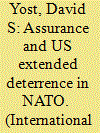

|
|
|
|
|
| Publication |
2009.
|
| Summary/Abstract |
Historically the NATO allies have focused considerable attention on US 'extended deterrence'- that is, the extension by Washington of an umbrella of protection, sometimes called a 'nuclear guarantee'. A persisting requirement has been to provide the allies with assurance about the reliability and credibility of this protection. This article examines the definition of 'assurance' used by the US Department of Defense for most of the past decade and argues that it has drawn attention to long-standing policy challenges associated with US extended deterrence in NATO. The article considers the assurance roles of US nuclear forces in Europe, as well as elements of assurance in Washington's relations with its allies regarding extended nuclear deterrence. Whether the allies will retain the current requirements of extended deterrence and assurance in their new Strategic Concept or devise a new approach will be an issue of capital importance in the policy review launched at the Strasbourg/Kehl Summit. Contrasting approaches to these questions are visible in the United States and Germany, among other allies. The main issues to be resolved include reconciling extended deterrence with arms control priorities; managing the divisions in public and expert opinion; and avoiding certain potential consequences of a rupture with established arrangements.
|
|
|
|
|
|
|
|
|
|
|
|
|
|
|
|
| 3 |
ID:
138947


|
|
|
|
|
| Summary/Abstract |
Russia, the United Kingdom and the United States extended security assurances to Ukraine in December 1994 in an agreement that became known as the Budapest Memorandum. This agreement was part of a package of arrangements whereby Ukraine transferred the Soviet-made nuclear weapons on its territory to Russia and acceded to the Treaty on the Non-Proliferation of Nuclear Weapons (NPT) as a non-nuclear weapon state (NNWS). Russia's violations of the Budapest Memorandum, notably its annexation of Crimea, could have far-reaching implications for nuclear non-proliferation and disarmament because of the questions that Russia's behaviour has raised about the reliability of major-power security assurances for NNWS parties to the NPT. Doubts about the reliability of such assurances could create incentives to initiate, retain or accelerate national nuclear weapons programs. Moreover, because the Budapest Memorandum included restatements of UN Charter provisions and principles articulated in the Helsinki Final Act of the Conference on Security and Co-operation in Europe, Russia's disregard for the Budapest Memorandum has raised fundamental questions about the future of international order. The Russians have demonstrated that, despite economic sanctions and international condemnation, they are prepared to disregard longstanding legal and political norms, including those expressed in the Budapest Memorandum, in pursuit of strategic and economic advantages and the fulfilment of national identity goals. Unless Russia reverses its dangerous course, the fate of the Budapest Memorandum may in retrospect stand out as a landmark in the breakdown of international order.
|
|
|
|
|
|
|
|
|
|
|
|
|
|
|
|
| 4 |
ID:
002095
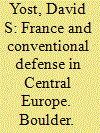

|
|
|
|
|
| Publication |
Boulder, Westview Press, 1985.
|
| Description |
x, 132p.
|
| Series |
Westview special studies in Military Affairs
|
| Standard Number |
081337054X
|
|
|
|
|
|
|
|
|
|
|
|
Copies: C:1/I:0,R:0,Q:0
Circulation
| Accession# | Call# | Current Location | Status | Policy | Location |
| 028427 | 355.033044/YOS 028427 | Main | On Shelf | General | |
|
|
|
|
| 5 |
ID:
033417
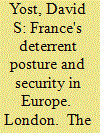

|
|
|
|
|
| Publication |
London, The International Institute for strategic studies, 1985.
|
| Description |
72p.
|
| Series |
Adelphi papers No. 194
|
| Contents |
Part 1: Capabilities and doctrine
|
| Standard Number |
0860790762
|
|
|
|
|
|
|
|
|
|
|
|
Copies: C:1/I:0,R:0,Q:0
Circulation
| Accession# | Call# | Current Location | Status | Policy | Location |
| 025100 | 355.02170941/YOS 025100 | Main | On Shelf | General | |
|
|
|
|
| 6 |
ID:
072174
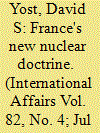

|
|
|
| 7 |
ID:
076518
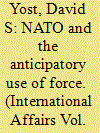

|
|
|
|
|
| Publication |
2007.
|
| Summary/Abstract |
Only since the end of the Cold War, and particularly since September 2001, have questions of anticipatory action arisen in alliance deliberations concerning the use of force. In initiating their Balkan operations, it should be recalled, the allies did not face direct threats, but intervened toterminate conflicts and human rights abuses and to shape their security environment. It has been difficult for the alliance to get to grips with the new security challenges presented by terrorism and the proliferation of weapons of mass destruction because of its history, its intrinsic character, and the nature of the new security challenges. Its history includes a strictly reactive posture during the Cold War and its interventions from a position of overwhelming superiority in the Balkan conflicts. The new security challenges place under stress the alliance's intrinsic character as a permanent coalition of sovereign independent states committed to collective defence because these challenges may endanger specific allies to differing degrees (in contrast with the overarching Soviet threat during the Cold War) and revealdiff erences in interests, capabilities and strategic cultures among the allies. The allies have not yet resolved questions concerning the legality and legitimacy of the antici patory use of force, nor have they fully explored the implications of concepts such as `constructive abstention' and `NATO in support' with regard to preemptive or preventive operations undertaken by a group of allies.
|
|
|
|
|
|
|
|
|
|
|
|
|
|
|
|
| 8 |
ID:
018012


|
|
|
|
|
| Publication |
2000.
|
| Description |
p.97-128
|
|
|
|
|
|
|
|
|
|
|
|
|
|
|
|
| 9 |
ID:
095074


|
|
|
|
|
| Publication |
2010.
|
| Summary/Abstract |
Is there a conflict between the Alliance's original and enduring purpose of collective defence and its post-Cold War crisis management functions? This is an ill-framed debate, because the home base must be secure in order to support expeditionary power projection. The allies have, moreover, moved away from a static, reactive, and territorial concept of collective defence towards a more 'proactive' and 'anticipatory' approach. Some experts have even referred to a 'deterritorialization' of collective defence. Other issues also illustrate the changing dimensions of collective defence-missile defence, cyber warfare, space operations, the risk of state-sponsored terrorism involving weapons of mass destruction, political-military dynamics in the Middle East and the Asia-Pacific region, and the risk of a non-Article 5 operation becoming a collective defence contingency. Despite disagreements on how to pursue shared goals, the allies may yet demonstrate that they have the vision and political will to meet the new challenges. The question of the Alliance's 'level of ambition' in capabilities is inseparable from that of its agreed purposes and burden-sharing to achieve them.
|
|
|
|
|
|
|
|
|
|
|
|
|
|
|
|
| 10 |
ID:
031493


|
|
|
|
|
| Publication |
New York, Pergamon Press, 1981.
|
| Description |
xxiv,258p.
|
| Series |
pergamon policy studies on security affairs.
|
| Standard Number |
0080271847
|
|
|
|
|
|
|
|
|
|
|
|
Copies: C:1/I:0,R:0,Q:0
Circulation
| Accession# | Call# | Current Location | Status | Policy | Location |
| 020908 | a355.02201821/YOS 020908 | Main | On Shelf | General | |
|
|
|
|
| 11 |
ID:
061166
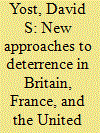

|
|
|
| 12 |
ID:
065648


|
|
|
|
|
| Publication |
1998.
|
| Description |
p.135-160
|
|
|
|
|
|
|
|
|
|
|
|
|
|
|
|
| 13 |
ID:
181996


|
|
|
|
|
| Summary/Abstract |
I first met Colin Gray in 1974 in Los Angeles when he spoke at the University of Southern California at the invitation of Professor William R. Van Cleave, the head of USC’s Defense and Strategic Studies Program. In introducing Colin, Professor Van Cleave joked that Colin had written half the books in the library — a prophetic jest.
|
|
|
|
|
|
|
|
|
|
|
|
|
|
|
|
| 14 |
ID:
034189


|
|
|
|
|
| Publication |
London, Harvard University Press, 1988.
|
| Description |
xii, 405p.
|
|
|
|
|
|
|
|
|
|
|
|
Copies: C:1/I:0,R:0,Q:0
Circulation
| Accession# | Call# | Current Location | Status | Policy | Location |
| 031561 | 358.17540947/YOS 031561 | Main | On Shelf | General | |
|
|
|
|
| 15 |
ID:
123117


|
|
|
|
|
| Publication |
2013.
|
| Summary/Abstract |
This article offers a survey of risks that might arise for strategic stability (defined as a situation with a low probability of major-power war) with the reduction of US and Russian nuclear arsenals to "low numbers" (defined as 1,000 or fewer nuclear weapons on each side). These risks might include US anti-cities targeting strategies that are harmful to the credibility of extended deterrence; renewed European anxiety about a US-Russian condominium; greater vulnerability to Russian noncompliance with agreed obligations; incentives to adopt destabilizing "launch-on-warning" strategies; a potential stimulus to nuclear proliferation; perceptions of a US disengagement from extended deterrence; increased likelihood of non-nuclear arms competitions and conflicts; and controversial pressures on the UK and French nuclear forces. Observers in North Atlantic Treaty Organization (NATO) states who consider such risks significant have cited four possible measures that might help to contain them: sustained basing of US nonstrategic nuclear weapons in Europe; maintaining a balanced US strategic nuclear force posture; high-readiness means to reconstitute US nuclear forces; and enhanced US and allied non-nuclear military capabilities. These concrete measures might complement the consultations with the NATO allies that the United States would in all likelihood seek with respect to such important adjustments in its deterrence and defense posture.
|
|
|
|
|
|
|
|
|
|
|
|
|
|
|
|
| 16 |
ID:
108415
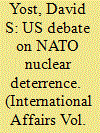

|
|
|
|
|
| Publication |
2011.
|
| Summary/Abstract |
NATO's nuclear deterrence posture has since the late 1950s involved risk-and responsibility-sharing arrangements based on the presence of US nuclear weapons in Europe. Since 1991 gravity bombs, deliverable by US and allied dual-capable aircraft, have been the only type of US nuclear weapons left in Europe. Although many other factors are involved in the alliance's deterrence posture and in US extended deterrence-including intercontinental forces, missile defences, non-nuclear capabilities and declaratory policy-recent discussions in the United States about NATO nuclear deterrence have focused on the future of the remaining US nuclear weapons in Europe. The traditional view has supported long-standing US and NATO policy in holding that the risk- and responsibility-sharing arrangements based on US nuclear weapons in Europe contribute to deterrence and war prevention; provide assurance to the allies of the genuineness of US commitments; and make the extended deterrence responsibility more acceptable to the United States. From this perspective, no further cuts in the US nuclear weapons presence in Europe should be made without an agreement with Russia providing for reductions that address the US-Russian numerical disparity in non-strategic nuclear forces, with reciprocal transparency and verification measures. In contrast, four schools of thought call for withdrawing the remaining US nuclear weapons in Europe without any negotiated Russian reciprocity: some military officers who consider the weapons and associated arrangements unnecessary for deterrence; proponents of ambitious arms control measures who accept extended deterrence policies but view the US weapons in Europe as an obstacle to progress in disarmament; nuclear disarmament champions who reject extended nuclear deterrence policies and who wish to eliminate all nuclear arms promptly; and selective engagement campaigners who want the United States to abandon extended nuclear deterrence commitments to allies on the grounds that they could lead to US involvement in a nuclear war.
|
|
|
|
|
|
|
|
|
|
|
|
|
|
|
|
| 17 |
ID:
052659
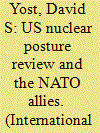

|
|
|
|
|
|
|
|